Indian Head Eagle

 $10 Indian Gold Eagles - Lady Liberty with a Native American headdress
$10 Indian Gold Eagles - Lady Liberty with a Native American headdress
The $10 Indian Gold Eagles replaced the $10 Liberty Gold Eagles in 1907. The coins were produced without interruption between 1907 and 1916 at the US Mint facilities in Philadelphia, San Francisco and Denver. After that, Indian Eagle coins were only produced in certain years until the final year of mintage 1933. Total mintage of the Indian Head Eagle came close to 15 million coins. The proof $10 Eagles are very rare gold coins however since proof coins were only minted in Philadelphia in very low numbers.
The Indian Gold Eagles are composed of 90% gold and 10% copper with each coin containing 0.48375 oz of gold. The obverse side of the coins shows a leftward facing Lady Liberty wearing a Native American headdress. An eagle that is standing on a bundle of arrows and an olive branch can be seen on the reverse of the Indian Head Gold Eagles. The motto "In God We Trust" appears on the reverse to the left of the eagle's breast since 1908. Images of Lady Liberty and an eagle appear in some form on many other pre-1933 U.S. gold coins.
When you buy gold in the form of $10 Indian Gold Eagle coins, you will discover a unique feature along the edge of the coins. The coins feature either 46 or 48 raised stars along their edge as a reference to the number of American states at that time (48 stars since 1912). American buyers that are investing in gold for their retirement should take note that the Indian Eagle gold coins are not eligible for inclusion in Individual Retirement Accounts (IRA's) since they are classified as collectible gold coins by the IRS.
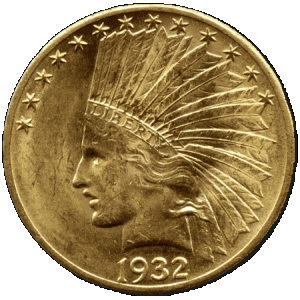
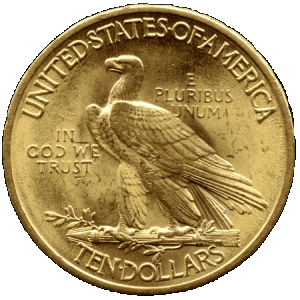
Coin Fact Sheet
| Weight | Face Value | Purity | Diameter |
|---|---|---|---|
| 0.48375 oz | US $ 10 | 90% | 27 mm |
Total Mintage: 14,868,589
Indian Eagle Coin Design
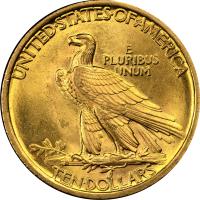
Augustus Saint-Gaudens' design of the $10 Indian Gold Eagles depicts a leftward facing Lady Liberty wearing a Native American headdress on the obverse side. The word “LIBERTY” is inscribed on Lady Liberty's headband. Thirteen stars above the portrait are meant to represent the original states of the United States.
The reverse side of the Indian Head Eagles depicts an eagle standing on a bundle of arrows and an olive branch. “E PLURIBUS UNUM” is inscribed to the right of the eagle's head and “IN GOD WE TRUST” appears to the left of the eagle's breast (from 1908 on). The image near the top of the page shows a coin from 1932 that has the motto on its reverse.
The coin's denomination ("TEN DOLLARS") and "UNITED STATES OF AMERICA" is inscribed along the lower and upper edge of the coin. Indian Head $10 coins that were minted in San Francisco (mintmark: S) or Denver (mintmark: D) contain a mintmark next to the bundle of arrows. However, coins that were minted at the main Philadelphia branch of the United States Mint don't have any mintmark.
The coin edge of the $10 Indian Gold Eagle is unique in that it features either 46 or 48 raised stars (from 1912 on), representing the number of American states at that time.
History of the $10 Indian Gold Eagle
The Indian Head Gold Eagle was commissioned by the American President Theodore Roosevelt in the early 1900's. The famous design was created by the US Mint sculptor Augustus Saint-Gaudens and production started in 1907. The first 2 years of production saw several variations in the design regarding the motto and the number of dots within and around the TEN DOLLARS denomination and E PLURIBUS UNUM.
Regular continuous production of the Indian Head Eagle ceased in 1916. The coins were from then on only produced in certain years (in 1920, 1926, 1930, 1932 and 1933). Almost the entire mintage of 1933 was melted down into bullion (due to currency laws passed during the Great Depression), making the rare surviving specimens especially valuable.
The motto "IN GOD WE TRUST" was added to the design of the reverse side of the coin in 1908. The Indian Gold Eagle therefore exists both with (1908 - 1933) and without motto (1907 - 1908). The coin image slightly above to the left shows one of those early coins without motto.
Even though production of the Indian Eagle coin lasted from 1907 to 1933, not all mint facilities were involved in every year and certain years saw no production at all.
Coin Variations
The coins that were minted in Philadelphia in 1907 include two varieties that are often referred to as "Wire Rim" and "Rounded Rim (or Rolled Rim)". The "Wire Rim" coins have a plain edge without the 46 raised stars on the rim and about 500 such pieces were minted. About 50 of the "Rounded Rim" coins still exist today.
Besides the added rim (that was neccessary to make the coins more easily stackable), these coins can be distinguished by additional dots around E PLURIBUS UNUM and/or TEN DOLLARS. Whereas one sub-variety (the rarer variety) has dots around and within TEN DOLLARS and E PLURIBUS UNUM (*E* *PLURIBUS* *UNUM* and *TEN*DOLLARS*), the other common variety has only one dot between TEN and DOLLARS.
Rare Dates
Especially hard to find are the coins that were minted in Philadelphia in 1907 (239,950 coins) and 1933 (most of the 312,500 coins were melted down and never left the mint) as well as the coins minted in San Francisco in 1920 (126,500 coins) and 1930 (96,000 coins).
Proof issues of the Indian Head version of the $10 Eagle were only minted in Philadelphia and are even rarer to find if at all possible. Proofs were only minted in certain years and mintage numbers varied from a minimum of 50 to a maximum of 204 coins.
Mintage Numbers
Annual mintage of the Indian Eagle gold coin at the various US Mint branches varied between 30,100 coins (Denver 1911) and 4,463,000 coins (Philadelphia 1932). Proof coins were exclusively minted at the Philadelphia branch of the US Mint between 1908 and 1915 and proof mintage varied between 50 coins (1914) and 204 coins (1910).
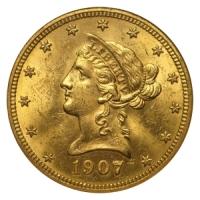
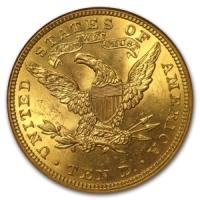
Liberty Gold Eagles
The $10 Liberty Gold Eagles were the predecessors of the $10 Indian Gold Eagles. The US Mint produced them from 1838 to 1907. The coins were struck at the US Mint facilities in Philadelphia, New Orleans, San Francisco, Carson City and Denver. They are composed of 90% gold and 10% copper with each coin containing 0.48375 oz of gold. Close to 43 million Liberty Eagle coins were minted. The design of the coins is the same as that of the bigger Double Eagles, depicting a leftward facing Lady Liberty in profile on the obverse and an eagle that is holding a shield on the reverse.
The Liberty Gold Eagle page gives more information about the coins and allows you to compare current prices.